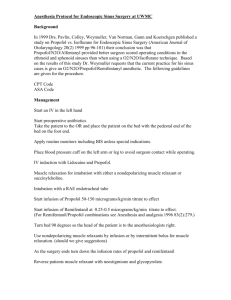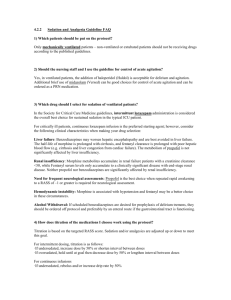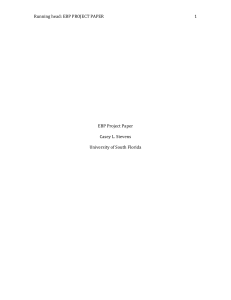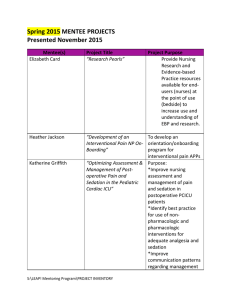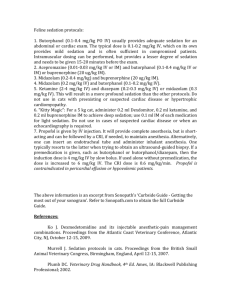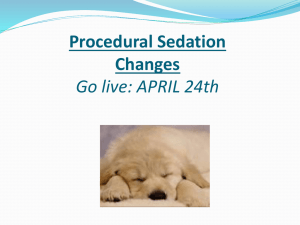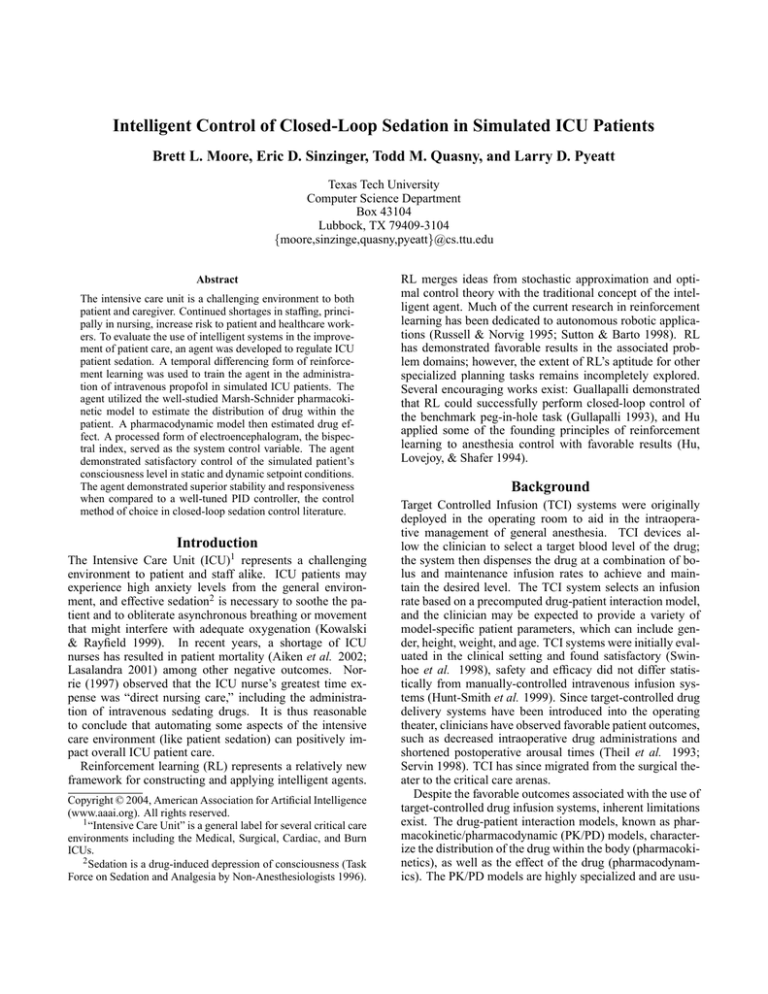
Intelligent Control of Closed-Loop Sedation in Simulated ICU Patients
Brett L. Moore, Eric D. Sinzinger, Todd M. Quasny, and Larry D. Pyeatt
Texas Tech University
Computer Science Department
Box 43104
Lubbock, TX 79409-3104
{moore,sinzinge,quasny,pyeatt}@cs.ttu.edu
Abstract
The intensive care unit is a challenging environment to both
patient and caregiver. Continued shortages in staffing, principally in nursing, increase risk to patient and healthcare workers. To evaluate the use of intelligent systems in the improvement of patient care, an agent was developed to regulate ICU
patient sedation. A temporal differencing form of reinforcement learning was used to train the agent in the administration of intravenous propofol in simulated ICU patients. The
agent utilized the well-studied Marsh-Schnider pharmacokinetic model to estimate the distribution of drug within the
patient. A pharmacodynamic model then estimated drug effect. A processed form of electroencephalogram, the bispectral index, served as the system control variable. The agent
demonstrated satisfactory control of the simulated patient’s
consciousness level in static and dynamic setpoint conditions.
The agent demonstrated superior stability and responsiveness
when compared to a well-tuned PID controller, the control
method of choice in closed-loop sedation control literature.
Introduction
The Intensive Care Unit (ICU)1 represents a challenging
environment to patient and staff alike. ICU patients may
experience high anxiety levels from the general environment, and effective sedation2 is necessary to soothe the patient and to obliterate asynchronous breathing or movement
that might interfere with adequate oxygenation (Kowalski
& Rayfield 1999). In recent years, a shortage of ICU
nurses has resulted in patient mortality (Aiken et al. 2002;
Lasalandra 2001) among other negative outcomes. Norrie (1997) observed that the ICU nurse’s greatest time expense was “direct nursing care,” including the administration of intravenous sedating drugs. It is thus reasonable
to conclude that automating some aspects of the intensive
care environment (like patient sedation) can positively impact overall ICU patient care.
Reinforcement learning (RL) represents a relatively new
framework for constructing and applying intelligent agents.
Copyright © 2004, American Association for Artificial Intelligence
(www.aaai.org). All rights reserved.
1 “Intensive Care Unit” is a general label for several critical care
environments including the Medical, Surgical, Cardiac, and Burn
ICUs.
2 Sedation is a drug-induced depression of consciousness (Task
Force on Sedation and Analgesia by Non-Anesthesiologists 1996).
RL merges ideas from stochastic approximation and optimal control theory with the traditional concept of the intelligent agent. Much of the current research in reinforcement
learning has been dedicated to autonomous robotic applications (Russell & Norvig 1995; Sutton & Barto 1998). RL
has demonstrated favorable results in the associated problem domains; however, the extent of RL’s aptitude for other
specialized planning tasks remains incompletely explored.
Several encouraging works exist: Guallapalli demonstrated
that RL could successfully perform closed-loop control of
the benchmark peg-in-hole task (Gullapalli 1993), and Hu
applied some of the founding principles of reinforcement
learning to anesthesia control with favorable results (Hu,
Lovejoy, & Shafer 1994).
Background
Target Controlled Infusion (TCI) systems were originally
deployed in the operating room to aid in the intraoperative management of general anesthesia. TCI devices allow the clinician to select a target blood level of the drug;
the system then dispenses the drug at a combination of bolus and maintenance infusion rates to achieve and maintain the desired level. The TCI system selects an infusion
rate based on a precomputed drug-patient interaction model,
and the clinician may be expected to provide a variety of
model-specific patient parameters, which can include gender, height, weight, and age. TCI systems were initially evaluated in the clinical setting and found satisfactory (Swinhoe et al. 1998), safety and efficacy did not differ statistically from manually-controlled intravenous infusion systems (Hunt-Smith et al. 1999). Since target-controlled drug
delivery systems have been introduced into the operating
theater, clinicians have observed favorable patient outcomes,
such as decreased intraoperative drug administrations and
shortened postoperative arousal times (Theil et al. 1993;
Servin 1998). TCI has since migrated from the surgical theater to the critical care arenas.
Despite the favorable outcomes associated with the use of
target-controlled drug infusion systems, inherent limitations
exist. The drug-patient interaction models, known as pharmacokinetic/pharmacodynamic (PK/PD) models, characterize the distribution of the drug within the body (pharmacokinetics), as well as the effect of the drug (pharmacodynamics). The PK/PD models are highly specialized and are usu-
ally derived from a small number of relatively healthy patients (Vuyk et al. 1995). These models are thus challenged
by disease pathologies, interactions with other pharmaceuticals, and other variabilities (even simple demographics) encountered in an actual patient.
Target-controlled infusion systems generally perform
open-loop control. The standard TCI system is not equipped
with a feedback mechanism and simply assumes the patient
responds in “average” fashion. Modeling errors resulting
from the above influences remain uncorrected. Albrecht
concluded that closed-loop sedation in the ICU is a rational component of sound patient care (Albrecht et al. 1999).
This conclusion is motivated in part by the rigors of the ICU
environment; sedation in the intensive care unit is not always a static process. Recent research indicates that waking
patients once a day may improve outcomes and shorten the
duration of mechanical ventilation (Kress et al. 2000). Furthermore, long-term ICU patients may develop a tolerance
to the drug and require greater doses to maintain sedative
effect (Fulton & Sorkin 1995). As Barr reports, the optimal
dosing of sedatives in the ICU is a dynamic, multivariate
process (Barr et al. 2001).
Most of the current research in closed-loop sedation uses
some form of electroencephalogram (EEG) as the control
variable (Leslie, Absalom, & Kenny 2002; Absalom, Sutcliffe, & Kenny 2002; Sakai, Matsuki, & Giesecke 2000;
Struys et al. 2001; Mortier et al. 1998). EEG is a wellstudied indicator of the state of the central nervous system,
and its analysis has been used in the diagnosis of neurological disorders, as well as the intraoperative monitoring
of anesthetic efficacy. The bispectral index (a processed
form of EEG) has been identified as a reliable indicator of
sedation for some drugs. Bispectral index, or BIS™ 3 , is
a statistically-derived measure of consciousness in which a
value of 100 indicates complete wakefulness, and 0 indicates
an isoelectric brain state.
Modeling the ICU Patient
The first choice in modeling the patient is drug selection.
From a purely engineering perspective, the choice of sedative agent is not particularly relevant. However, clinical
concerns drive drug selection, and the choice of drug determines the patient interaction model. Ideal sedative characteristics for the ICU include titrability, stable hemodynamic
responses, fast onset, and fast offset. Of the sedative agents
meeting these criteria, midazolam and propofol are the frontrunners; propofol is more generally favored for ICU sedation (Fulton & Sorkin 1995; Ronan et al. 1995). Mortier
observed that the bispectral index is a suitable control variable for control of propofol sedation (Mortier et al. 1998).
Several PK/PD models exist for propofol interaction. The
Marsh model is widely studied (Marsh et al. 1991) and represents the patient as a collection of three compartments:
central, rapid, and slow. The central compartment corresponds to the patient’s apparent volume of blood (and the
3 BIS™ is a trademark of Aspect Medical Systems, Newton,
MA.
Infusion
k13
k12
Slow
Central
Rapid
Compartment
Compartment
Compartment
k31
k21
k10
Metabolism
ke0
Effect Site
Figure 1: A four-compartment drug distribution model
site of drug infusion); the rapid and slow compartments represent different collections of tissue, fat, and bone. The
Marsh model is defined by the following diffusion constants:
• k10 metabolic clearance, 0.1190/min,
• k12 central to rapid clearance, 0.1120/min,
• k21 rapid to the central clearance, 0.0550/min,
• k13 central to rapid clearance,0.0419/min,
• k31 rapid to central clearance, 0.0033/min.
An improved model was obtained by adding a fourth compartment to model the drug’s effect site in the brain: ke0 =
1.2195/min (Struys et al. 2000; Marsh et al. 1991;
Schnider et al. 1999). Drug transport between compartments is governed by a set of first-order differential equations. Using Ψ to represent the four-element vector of compartmental quantities, distribution of propofol can be modeled with the following equations:
∂ψ1
= ψ2 (t)k21 + ψ3 (t)k31 − ψ1 (t) (k10 + k12 + k13 ) + I ,
∂t
∂ψ2
= ψ1 (t)k12 − ψ2 (t)k21 ,
∂t
∂ψ3
= ψ1 (t)k13 − ψ3 (t)k31 , and
∂t
∂ψe
= ψ1 (t)ke0 − ψe (t)ke0 .
∂t
Figure 1 presents a block diagram of the model4 . Figure 2
illustrates the model’s response to a bolus of propofol at t =
0. The dynamic nature of the model, particularly the effect
site’s delay in following the central compartment, present
interesting challenges for the controller.
Figures 1 and 2 illustrate pharmacokinetics, or drug distribution. The pharmacodynamics of propofol (the relation of
effect-site concentration to bispectral index) were estimated
using the following equation (Doi et al. 1997):
BISmeasured = −12.8 · υe + 93.6,
where υe was the effect site concentration of propofol.
4 Figure
1 also illustrates a physiological reality which limits
controllers using intravenous infusions. Propofol cannot be mechanically removed from the patient’s blood, and upward setpoint
changes can only be accommodated by the controller choosing a
“do-nothing” action.
Propofol
Central
Effect
Rapid
Slow
0
5
10
15
20
25
30
Time (min)
Figure 2: The model’s response to a bolus of propofol
Methods
This section outlines the agent’s architecture in terms of
learning method and state space representation. These discussions also cover implementation specifics including the
agent’s inputs, actions, and other learning parameters. This
section also describes the method of assessing agent performance.
Figure 3: A Q(λ) algorithm for learning optimal policies (Sutton & Barto 1998)
Actions
Learning Technique
The objective was to assess the suitability of reinforcement learning to ICU sedation. Watkins’ Q-learning technique (Watkins 1989) is appealing due to its mathematical
soundness (Sutton 1987; Dayan 1992; Tsitsiklas & Van Roy
1996) and has become the de facto standard in the study
of reinforcement learning. Q-learning is a temporal difference learning method characterized by model-free, offpolicy learning. This technique learns an action-value function by iteratively advancing intermediate policies to optimality. The equation below, a Bellman expression of the
Q-learning update rule, emphasizes an important aspect of
the technique: the value of a state-action pair is expressed
in terms of the value of successor states encountered under
policy π.
Qπ (ss, a) = ∑ π(ss, a) ∑ Pssa 0 R ass0 + γQπ (ss0 , a)
a
Initialize Q (ss, a), e (ss, a) ∀ s , a arbitrarily
Repeat (for each episode)
Initialize s , a
Repeat (for each step in the episode)
Take action a, observe r, and transition to s 0
Choose a0 from s 0 using ε-greedy policy
a∗ ← argmaxb Q (ss0 , b)
δ ← r + γQ (ss0 , a∗ ) − Q (ss, a)
e (ss, a) ← 1
∀ s, a
Q (ss, a) ← Q (ss, a) + αδe (ss, a)
If a0 = a∗ , e (ss, a) ← γλe (ss, a)
else e (ss, a) = 0
s ← s0
a ← a0
Until s is terminal
s0
The basic Q-learning algorithm has since been improved
to provide one of the strengths of dynamic programming,
multi-step backups. The resulting algorithm, Q(λ), is shown
in Figure 3. Q(λ) uses the eligibility trace and the parameter λ ∈ (0, 1) to vary temporal credit assignment for
faster learning (Sutton & Barto 1998). After experimentation, one favorable reward propagation scheme was observed when λ = 0.998, while γ (the reward discounting parameter) equaled 0.80.
Inputs
The agent utilized two external inputs and four internal inputs to control the patient’s level of consciousness. The
desired bispectral index and the measured bispectral index
were combined to form the control error, BISerror . The
agent also employed an internal instance of the MarshSchnider PK/PD model for estimates of the four compartmental propofol concentrations, ϒ = [υc , υr , υs , υe ].
The agent could choose from the following set of propofol
infusion rates A = {0.0, 0.1, 0.5, 1.0, 2.0, 4.0} (ml/min). To
maintain consistency with existing precision syringe pumps,
each action was considered atomic for a ten-second interval. Chosen actions were uninterruptible for this duration;
once an action expired, the agent was free to choose another
action from A .
Reward Function
Reward is an immediate mapping from state to value and is
the basis for agent’s goal: “a reinforcement learning agent’s
sole objective is to maximize the total reward it receives
in the long run (Sutton & Barto 1998).” Rewards may be
viewed as positive reinforcements for favorable behavior or
as negative reinforcements for unfavorable behavior. A successful agent was developed using the reward function below:
r = − |BISmeasured − BISdesired | = − |BISerror | .
This reward function was bounded to the interval (−100, 0).
State Space Representation
Reinforcement learning tasks frequently use a function approximator to store the value function (the basis for making optimal decisions). Uniformly discretized tables are
straightforward to implement and mathematically robust.
Baird observes, “Algorithms such as Q-learning. . . are guaranteed to converge to the optimal answer when used with a
lookup table (Baird 1995).” However, this approach is prone
to tractability problems as the table size grows exponentially
with increased dimension. The problem of concisely representing highly-dimensional state spaces is not new and has
been the object of study for some time (Sutton & Barto 1998;
Bellman, Kalaba, & Kotkin 1963). Regrettably, many alternatives fail to reliably converge to optimal policy when
Table 2: Tested sedation profiles
Profile
Interval
Target
(min)
BIS™
1
0 - 120
50
2
0 - 20
50
20 - 80
80
80 - 130
40
3
0 - 80
40
80 - 160
94
160 - 240
40
240 - 320
94
Table 1: Input ranges and partitions
Input
Min
Max
Units Knots
BISerror -20
20
BIS™
21
υc
0
1 × 105
µg
10
υr
0
1 × 105
µg
10
υs
0
1 × 105
µg
10
υe
0
8 × 104
µg
10
fˆ =
23 −1
∑ wi · f i ,
i=0
where wi is the interpolation weight at the ith vertex, and f i
is the function’s value at vertex pi . The interpolation weight
vector W is constrained such that fˆ = fi when the interpolating point is coincident with a cell vertex.
To apply the interpolation method to an arbitrary dimension d, the bounding region must be translated and scaled to
the unit hypercube. Given that X represents the coordinates
of the interpolation
point [x0 ,x1 , . . . , xd−1 ], F is the set of
vertex values f0 , f1 , . . . , fh2d −1 , and Pi represents
the set of
i
coordinates for vertex i, pi0 , pi1 , . . . , pi2d −1 , the following
equation may then be applied:
fˆ =
2d −1
d−1
i=0
j=0
∑ fi ∏
1 − x j − pij .
O (2d ),
This interpolation process is
but interpolating over
simplicial meshes (rather than hypercubes) can reduce the
complexity to O (d) (Munos & Moore 1999).
Table 1 summarizes the RL agent inputs, as well as the
number of partitions for each dimension. The value function approximation consisted of 1.26 × 106 entries (one fivedimensional table of 210,000 entries for each of the six possible actions).
Performance Evaluation
The root-mean-squared error (RMS error) metric was used
to evaluate the performance of the agent over three differ-
100
90
80
BIS™
used with reinforcement learning (Thrun & Schwartz 1993;
Boyan & Moore 1995; Sutton & Barto 1998).
One alternative is to enhance the discretized table with
linear interpolation. The interpolated representation partitions the space in a manner similar to the discretized table. However, the partition boundaries now serve as control points for a first-order spline approximation. This technique assumes that regions between the partition boundaries
may be satisfactorily fit in piecewise-linear fashion; hence,
linear interpolation represents the value function in continuous space. Davies (1997) observed good performance with
linearly interpolated value functions, though the state space
was coarsely partitioned. Gordon (1995) developed a proof
of convergence for a class of fitted temporal difference algorithms that includes linear interpolation.
To generalize linear interpolation, first consider the threedimensional case. Given a regular bounding region in 3space, the interpolated value fˆ may be determined by:
70
PID
60
RL
50
40
0
2
4
6
8
10
12
14
Time (min)
Figure 5: Observed responses to setpoint transition
ent sedation profiles. These profiles, summarized in Table 2,
assessed the agent’s control capacity under a variety of transient and steady state conditions. While the exact timings
and target BIS™ levels were somewhat arbitrarily chosen,
they represent fair and reasonable dosing events. For comparison, a proportional-integral-derivative (PID) controller
was also constructed. The equation below summarizes a basic parallel PID control law in which a controlling signal, u,
is computed from the weighted proportional, integral, and
derivative terms:
u = Kp e +
1
Ki
Z
edt + Kd
∂e
.
∂t
The PID controller performed well for constants K p = 0.1,
Ki = 600, and Kd = 0.8 where u was the prescribed infusion
rate and e = BISerror .
Results and Discussion
Both the RL agent and the benchmark PID controller
demonstrated good control characteristics. Figure 4 illustrates the behavior during one of the more challenging sedation profiles. As shown, the agent effected a quick transition
to the initial setpoint, then maintained the setpoint with minimal deviation. At t = 80, a waking event was simulated and
the agent correctly chose the “do-nothing” action allowing
the patient to clear the drug and approach consciousness. At
t = 160, deep sedation was targeted again. Although the
patient’s propofol load differed significantly from the initial
transition, the agent achieved this setpoint equally well. Table 3 summarizes the RMS error for all tested profiles.
100
BIS™
80
60
40
0
50
100
150
200
250
300
Time (min)
Figure 4: RL agent using linearly interpolated value function approximation (RMSE=13.72)
Table 3: RMS error observed in tested profiles
Profile
PID
RL
#1
4.93
4.12
#2
7.25
6.73
#3
17.63 13.72
Benefits
The intelligent agent demonstrated an ability to reliably control the simulated patient’s consciousness level through transition and steady-state periods (Figure 4). Table 3 illustrates satisfactory control over all tested scenarios. Figure 5
is particularly encouraging; short, controlled transitions are
highly favored in sedation, but are a challenge for automation 5 .
From an applied standpoint, provably optimal solutions
(such as the RL agent) are appealing in life-critical applications. The bounded, tabular nature of the agent’s world
model assures that well-defined behaviors are associated
with each state in the model. In addition, the temporal difference learning method deterministically yields the optimal control policy under reasonable assumptions. It is also
important to note that constant-coefficient PID controllers
(such as the benchmark controller and those used in current sedation research (Leslie, Absalom, & Kenny 2002;
Absalom, Sutcliffe, & Kenny 2002)) are optimal only in the
average sense. Undesirable control characteristics, like the
oscillations reported by Leslie and Absalom, are not uncommon when PID control is applied to noisy, uncertain processes.
Limitations and Future Work
The RL agent studied in this work encountered three closelyrelated limitations. First, the agent assumed the patient
would respond in the “average” fashion stipulated by the
Marsh-Schnider model. Of course, the individual patient
can be expected to vary from this ideal to some unknown
degree. Second, the Marsh-Schnider PK model considers
the patient weight to be an influential cofactor; however, this
research was limited to simulated patients weighing 70 kg.
5A
recent study in sedation relied on the clinician to manually
effect the initial loading of propofol (Leslie, Absalom, & Kenny
2002).
Lastly, the agent’s internal Marsh-Schnider model assumed
no propofol was present in the patient’s system prior to its
administration of the drug. (Propofol is commonly used in
the operating room, and the intensive care unit is a frequent
destination for post-operative patients.) All of these limitations could be removed if the agent were equipped with
online adaptivity: the capability to modify the learned value
function in the presence of a systematic control bias.
The next step is to ready the agent for the rigors of control in the actual environment. Physiological systems are
notorious for their uncertainty and noise, and the agent must
be prepared to handle noisy observations, as well as biased patient responses. Once these measures are established,
the agent can be evaluated outside of simulation. It is expected that the RL agent will regulate consciousness more
effectively than existing techniques, and this hypothesis can
be confirmed under controlled laboratory trials using human subjects (with appropriate review board approval and
a physician’s supervision). These trials would also present
an opportunity to improve the agent and support enhancements, such as online learning.
Conclusions
ICU patient sedation proved to be an interesting experiment
in intelligent system control. The domain was challenging,
but well-defined: prior clinical research demonstrated the
efficacy of the bispectral index as a control variable, and existing pharmacokinetic/pharmacodynamic models provided
a workable simulated patient. The RL agent demonstrated
an ability to regulate the simulated patient’s consciousness
within acceptable limits, and the agent learned to dose the
patient with the characteristics of good process control:
rapid, well-managed transitions with stable steady-state responses. The RL agent compared favorably with the PID
controller, a conventional control technique currently being
applied in closed-loop sedation research.
Acknowledgments
This work was supported in part by NASA grant
NNJ04HC19G.
References
Absalom; Sutcliffe; and Kenny. 2002. Closed-loop control of
anesthesia using bispectral index performance assessment in pa-
tients undergoing major orthopedic surgery under combined general and regional anesthesia. Anesthesiology 96(1):67–73.
Aiken; Clarke; Sloane; Sochalski; and Silber. 2002. Hospital
nurse staffing and patient mortality, nurse burnout, and job dissatisfaction. JAMA 288(16):1987–1993.
Albrecht; Frenkel; Ihmsen; and Schuttler. 1999. A rational approach to the control of sedation in intensive care unit patients
based on closed-loop control. Eur J Anaesthesiol 16(10):678–
687.
Baird. 1995. Residual algorithms: Reinforcement learning with
function approximation. In Proc. 12th International Conference
on Machine Learning, 30–37. Morgan Kaufmann.
Barr; Egan; Sandoval; Zomorodi; Cohane; Gambus; and Shafer.
2001. Propofol dosing regimens for ICU sedation based upon an
integrated pharmacokinetic-pharmacodynamic model. Anesthesiology 95(2):324–333.
Bellman; Kalaba; and Kotkin. 1963. Polynomial approximation–
A new computational technique in dynamic programming: Allocation processes. J Math Comput 17(82):155–161.
Boyan, and Moore. 1995. Generalization in reinforcement learning: Safely approximating the value function. In Advances in
Neural Information Processing Systems 7, 369–376. The MIT
Press.
Davies. 1997. Multidimensional triangulation and interpolation
for reinforcement learning. In Advances in Neural Information
Processing Systems, volume 9, 1005–1011. The MIT Press.
Dayan. 1992. The convergence of TD(λ) for general λ. Machine
Learning 8:341–362.
Doi; Gajraj; Mantzaridis; and Kenny. 1997. Relationship between
calculated blood concentration of propofol and electrophysiological variables during emergence from anaesthesia: Comparison of
bispectral index, spectral edge frequency, median frequency and
auditory evoked potential index. Br J Anaesth 78(2):180–4.
Fulton, and Sorkin. 1995. Propofol. An overview of its pharmacology and a review of its clinical efficacy in intensive care
sedation. Drugs 50(4):636–57.
Gordon. 1995. Stable function approximation in dynamic programming. In Proceedings of the Twelfth International Conference on Machine Learning, 261–268. Morgan Kaufmann.
Gullapalli. 1993. Learning control under extreme uncertainty. In
Advances in Neural Information Processing Systems, volume 5,
327–334. Morgan Kaufmann, San Mateo, CA.
Hu; Lovejoy; and Shafer. 1994. Comparison of some control strategies for three-compartment PK/PD models. Journal of
Pharmacokinetics and Biopharmaceutics 22(6):525–550.
Hunt-Smith; Donaghy; Leslie; Kluger; Gunn; and Warwick.
1999. Safety and efficacy of target controlled infusion (Diprifusor) vs manually controlled infusion of propofol for anaesthesia.
Anaesth Intensive Care 27(3):260–264.
Kowalski, and Rayfield. 1999. A post hoc descriptive study of
patients receiving propofol. Am J Crit Care 8(1):507–13.
Kress; Pohlman; O’Connor; and Hall. 2000. Daily interruption of
sedative infusions in critically ill patients undergoing mechanical
ventilation. N Engl J Med 342(20):1471–7.
Lasalandra. 2001. Norwood hospital staff shortage eyed in
patient’s death.
http://www.bostonherald.com/
news/local_regional/cari01152001.htm:
World
Wide Web.
Leslie; Absalom; and Kenny. 2002. Closed loop control of sedation for colonoscopy using the bispectral index. Anaesthesia
57(7):690–709.
Marsh; White; Morton; and Kenny. 1991. Pharmacokinetic model
driven infusion of propofol in children. Br J Anaesth 67(1):41–8.
Mortier; Struys; De Smet; Versichelen; and Rolly. 1998. Closedloop controlled administration of propofol using bispectral analysis. Anaesthesia 53(8):749–754.
Munos, and Moore. 1999. Variable resolution discretization for
high-accuracy solutions of optimal control problems. In IJCAI,
1348–1355.
Norrie. 1997. Nurses’ time management in intensive care. Nurs
Crit Care 2(3):121–125.
Ronan; Gallagher; George; and Hamby. 1995. Comparison of
propofol and midazolam for sedation in intensive care unit patients. Crit Care Med 23(2):286–93.
Russell, and Norvig. 1995. Artificial Intelligence. Prentice-Hall.
Sakai; Matsuki; and Giesecke. 2000. Use of an EEG-bispectral
closed-loop delivery system for administering propofol. Acta
Anesthesiologica Scandinavica 44:1007–1010.
Schnider; Minto; Shafer; Gambus; Andresen; Goodale; and
Youngs. 1999. The influence of age on propofol pharmacodynamics. Anesthesiology 90(6):1502–16.
Servin. 1998. TCI compared with manually controlled infusion of
propofol: A multicentre study. Anaesthesia 53(Suppl 1):82–86.
Struys; De Smet; Depoorter; Versichelen; Mortier; Dumortier;
Shafer; and Rolly. 2000. Comparison of plasma compartment
versus two methods for effect compartment-controlled targetcontrolled infusion for propofol. Anesthesiology 92(2):399–406.
Struys; De Smet; Versichelen; Van De Velde; Van den Broecke;
and Mortier. 2001. Closed-loop controlled administration of
propofol using bispectral analysis. Anesthesiology 95(1):6–17.
Sutton, and Barto. 1998. Reinforcement Learning: An Introduction. MIT Press.
Sutton. 1987. Learning to predict by the method of temporal
differences. Technical Report TR87-509.1, University of Massachusetts.
Swinhoe; Peacock; Glen; and Reilly. 1998. Evaluation of the
predictive performance of a ’Diprifusor’ TCI system. Anaesthesia
53(Suppl 1):61–67.
Task Force on Sedation and Analgesia by Non-Anesthesiologists.
1996. Practice guidelines for sedation and analgesia by nonanesthesiologists. Anesthesiology 84(2):459–471.
Theil; Stanley; White; Goodman; Glass; Bai; Jacobs; and Reves.
1993. Midazolam and fentanyl continuous infusion anesthesia for
cardiac surgery: a comparison of computer-assisted versus manual infusion systems. J Cardiothorac Vasc Anesth 7(3):300–6.
Thrun, and Schwartz. 1993. Issues in Using Function Approximation for Reinforcement Learning. In Proceedings of the 1993
Connectionist Models Summer School. Lawrence Erlbaum.
Tsitsiklas, and Van Roy. 1996. An analysis of temporal difference
learning with function approximation. Technical Report LIDS-P2322, Massachusetts Institute of Technology.
Vuyk; Engbers; Burm; Vletter; and Bovill. 1995. Performance of
computer-controlled infusion of propofol: An evaluation of five
pharmacokinetic parameter sets. Anesth Analg 81(6):1275–1282.
Watkins. 1989. Learning from Delayed Rewards. PhD dissertation, Cambridge University, Computer Science Department.


